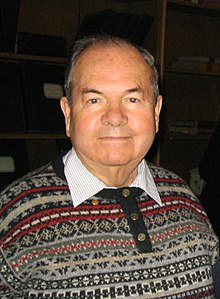Alexei Abrikosov (physicist)
Alexei Abrikosov | |
|---|---|
 | |
| Born | Alexei Alexeyevich Abrikosov June 25, 1928 |
| Nationality | Russian |
| Alma mater | Moscow State University USSR Academy of Sciences |
| Known for | Condensed matter physics |
| Spouse | Svetlana Yuriyevna Bunkova (m. 1977; 3 children) |
| Awards | Nobel Prize in Physics (2003) |
| Scientific career | |
| Fields | Physics |
| Institutions | Landau Institute Moscow State University Moscow Institute of Physics and Technology Argonne National Laboratory |
| Notes | |
He is the son of the physician Alexei Ivanovich Abrikosov | |
Alexei Alexeyevich Abrikosov (Russian: Алексе́й Алексе́евич Абрико́сов; born June 25, 1928) is a Soviet and Russian theoretical physicist whose main contributions are in the field of condensed matter physics. He was awarded the Nobel Prize in Physics in 2003.
Biography
Abrikosov was born in Moscow, Russian SFSR, USSR, on June 25, 1928, to a couple of physicians: Prof. Alexei Ivanovich Abrikosov and Dr. Fani Abrikosova, née Wulf. He graduated from Moscow State University in 1948. From 1948 to 1965, he worked at the Institute for Physical Problems of the USSR Academy of Sciences, where he received his Ph.D. in 1951 for the theory of thermal diffusion in plasmas, and then his Doctor of Physical and Mathematical Sciences degree in 1955 for a thesis on quantum electrodynamics at high energies. From 1965 to 1988, he worked at the Landau Institute for Theoretical Physics (USSR Academy of Sciences). He has been a professor at Moscow State University since 1965. In addition, he held tenure at the Moscow Institute of Physics and Technology from 1972 to 1976, and at the Moscow Institute of Steel and Alloys from 1976 to 1991. He served as a full member of the USSR Academy of Sciences from 1987 to 1991. In 1991, he became a full member of the Russian Academy of Sciences.
In two works in 1952 and 1957, Abrikosov explained how magnetic flux can penetrate a class of superconductors. This class of materials is known as type-II superconductors. The accompanying arrangement of magnetic flux lines is called the Abrikosov vortex lattice.
Since 1991, he has been working in the Materials Science Division at Argonne National Laboratory in Illinois on a contract basis. Abrikosov is an Argonne Distinguished Scientist at the Condensed Matter Theory Group in Argonne’s Materials Science Division. His recent research at Argonne National Laboratory has focused on the origins of magnetoresistance, a property of some materials that change their resistance to electrical flow under the influence of a magnetic field.
Honours and awards
Abrikosov was awarded the Lenin Prize in 1966, the Fritz London Memorial Prize in 1972, and the USSR State Prize in 1982. In 1989 he received the Landau Prize from the Academy of Sciences, Russia. Two years later, in 1991, Abrikosov was awarded the Sony Corporation’s John Bardeen Award. The same year he was elected a Foreign Honorary Member of the American Academy of Arts and Sciences.[1] He is also a member of the Royal Academy of London, a fellow of the American Physical Society, and in 2000 was elected to the prestigious National Academy of Sciences. He was the co-recipient of the 2003 Nobel Prize in Physics, with Vitaly Ginzburg and Anthony James Leggett, for theories about how matter can behave at extremely low temperatures.
Other awards include:
- Member of the Academy of Sciences of the USSR (now Russian Academy of Sciences), 1964
- Lenin Prize, 1966
- Honorary Doctor of the University of Lausanne, 1975
- Order of the Badge of Honour, 1975
- Order of the Red Banner of Labour, 1988
- USSR State Prize, 1982
- Academician of the Academy of Sciences of the USSR (now Russian Academy of Sciences) 1987
- Landau Prize, 1989
- John Bardeen Award, 1991
- Foreign Honorary Member of the American Academy of Arts and Sciences, 1991
- Member of the National Academy of Sciences, USA, 2000
- Foreign Member of the Royal Society of London, 2001
- Nobel Prize in Physics, 2003
References
- ^ "Book of Members, 1780–2010: Chapter A" (PDF). American Academy of Arts and Sciences. Retrieved 20 March 2011.
Further reading
- Abrikosov, A. A. “Theory of an Unusual Metal-Insulator Transition in Layered High-Tc Cuprates”, Materials Science Division, Argonne National Laboratory, United States Department of Energy,(August 28, 2003).
- Abrikosov, A. A. “Theory of High-{Tc} Superconducting Cuprates Based on Experimental Evidence”, Materials Science Division, Argonne National Laboratory, United States Department of Energy,(Dec. 10, 1999).
- Abrikosov, A. A. “New Developments in the Theory of HTSC (High Temperature Superconductors)”, Materials Science Division, Argonne National Laboratory, United States Department of Energy, Office of Energy Research,(Sept. 1994).
- Abrikosov, A. A. "On the magnetic properties of superconductors of the second group", Soviet Physics JETP 5, 1174 (1957), page scans of the original article.
- “Argonne Scientist Wins 2003 Nobel Prize for Physics” McGregor, S., Oct. 7, 2003, press release.
External links
- Biography and Bibliographic Resources, from the Office of Scientific and Technical Information, United States Department of Energy
- A Short Biography, on the website of the Material Science Division of Argonne National Laboratory
- 1928 births
- Members of the United States National Academy of Sciences
- Foreign Members of the Royal Society
- Living people
- Full Members of the USSR Academy of Sciences
- Full Members of the Russian Academy of Sciences
- Moscow State University alumni
- Moscow State University faculty
- Moscow Institute of Physics and Technology faculty
- Nobel laureates in Physics
- Lenin Prize winners
- Recipients of the Order of the Badge of Honour
- Recipients of the Order of the Red Banner of Labour
- USSR State Prize winners
- Russian Nobel laureates
- Russian physicists
- Soviet physicists
- Superconductivity
- Fellows of the American Academy of Arts and Sciences
- Theoretical physicists
